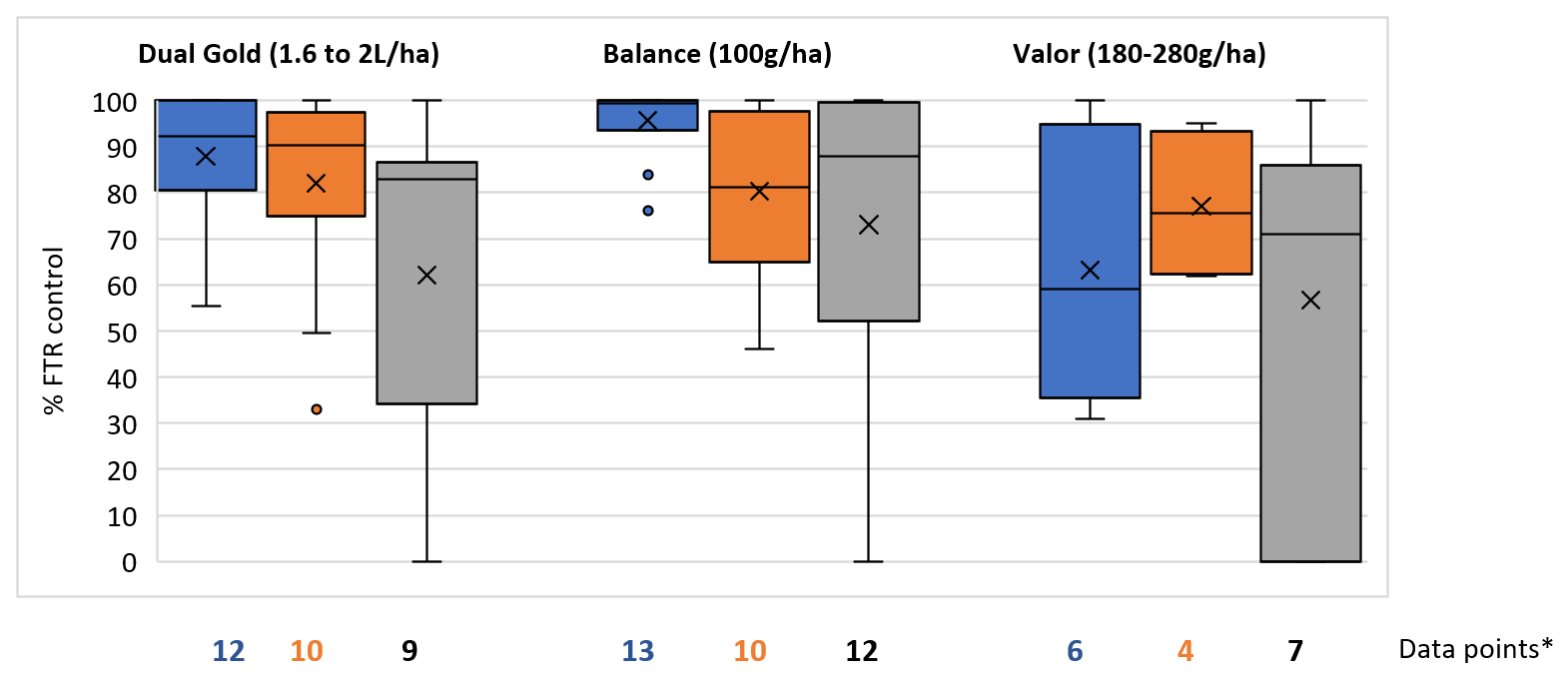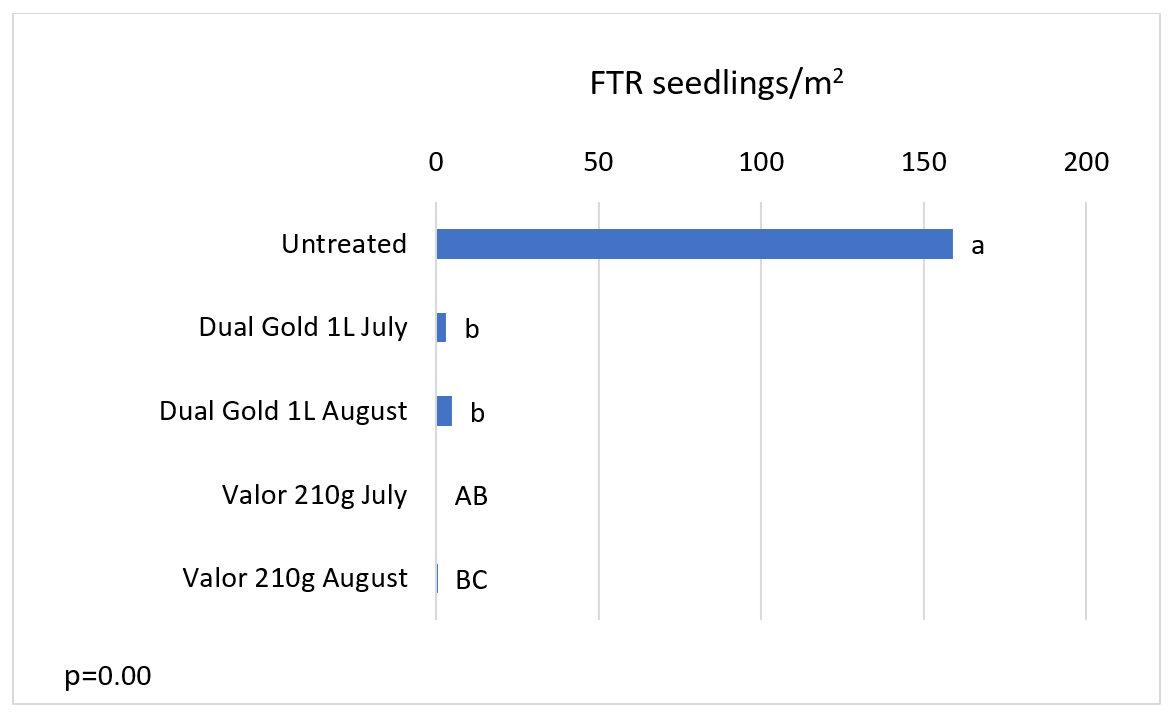Managing problem summer grass weeds with pre emergents
Author: Richard Daniel, Linda Bailey, Rachel Norton, Denielle Smith, Lawrie Price (Northern Grower Alliance), Branko Duric (NSW DPI) | Date: 26 Jul 2022
Take home messages
- Feathertop Rhodes grass (FTR) poses a major challenge due to the lack of low cost, effective knockdown herbicide options
- Effective pre-emergent chemistry options are available from a range of mode of action groups
- Winter/spring residual application prior to sorghum appears promising to improve FTR control
- At-planting residual options in wheat are unlikely to assist due to the length of residual control required, crop safety constraints and high cost for an ‘insurance’ type treatment.
Background
Management of summer grass weeds has become a significant economic cost and major agronomic challenge in many areas of the northern grain’s region. This can be as a result of: selection of resistant/ tolerant grass populations from prolonged use of glyphosate, reduction in grass weed efficacy when broadleaf herbicides are tank mixed with glyphosate, reduced efficacy due to temperature/heat stress at application or delays in application timing.
Regardless of the reason, growers need a range of alternative management approaches to assist with key problem grass weeds. This paper will focus on the potential and fit of residual herbicides for the management of feathertop Rhodes grass (FTR), which has in recent years become the major problem summer grass across the region. Some of the strategies discussed are also applicable to problem weeds such as awnless barnyard grass, however differences in the ecology of FTR allow consideration of alternative management strategies.
1. Summer fallow management with residuals
The most successful strategies employed by growers for managing FTR have included the use of residual herbicides. Either directly targeted at known FTR problem paddocks, or more broadly, by keeping FTR at bay when targeting other grass weed problems on the farm. The viability of most other grass weed seeds in the soil is longer than for FTR, so when growers are incorporating residual herbicides into their program to manage grass weeds such as awnless barnyard grass, FTR is often also controlled or suppressed.
Balance® can be a particularly effective option for fallow management. In addition to residual control of FTR, it will also control flaxleaf fleabane and common sowthistle with suppression of awnless barnyard grass, however significant plantback periods apply for many summer crop options.
Dual Gold® is registered for residual control of FTR prior to planting a wide range of summer crops and also in fallow situations, with minimal plantback constraints. A new use pattern also allows for a top-up application in sorghum after crop emergence.
Valor®, applied at rates for residual control, is registered in summer fallow but is also an option prior to planting selected summer crops. Plantback periods apply for some summer crops when using Valor, so always check the label. In addition to control of FTR, Valor can also provide residual control of a range of difficult to control broadleaf weeds such as flaxleaf fleabane, common sowthistle, red pigweed, caltrop, bladder ketmia and Ipomea species such as bell vine and morning glory.
Figure 1 shows a snapshot of efficacy results from registered fallow options at varying periods after application. The blue columns show residual control when assessed in the first 48 days after application, orange columns show levels of control when assessed 58-77 days after application and the grey columns show levels of control 81-147 days after application.
Figure 1. Summary of 22 residual herbicide trials (2007-2016) (NGA, QDAF, GOA, NSW DPI)
Blue 14-48 DAA Orange 58-77 DAA Grey 81-147 DAA
*Not all treatments were included in all trials. Some trials had more than one rate of herbicide included.
Some trials had two ratings within the same time grouping.
2. Winter/spring fallow management with residuals
Although FTR is generally considered a summer grass weed, emergences can be seen in winter. Field experience suggest that periods of soil wetness are more important than temperature for FTR germination and emergence.
Glasshouse studies by Queensland Department of Agriculture and Fisheries (Werth 2017) showed that FTR will emerge following as little as a 10mm simulated rainfall event however larger rainfall events resulted in increased emergence.
Awnless barnyard grass, common sowthistle and flaxleaf fleabane were also included in the same study. The rainfall requirement for emergence of FTR was less than for awnless barnyard grass, especially at cooler temperatures (15/200C compared to 20/300C), while rainfall >20mm was required to provide significant emergence of common sowthistle and flaxleaf fleabane. The ability of FTR to establish on lower rainfall highlights one of the reasons that FTR is often the first weed to establish following spring rainfall.
Both the field and glasshouse experience indicate FTR emergence, particularly during July to September is likely to be a more frequent and bigger management risk than for awnless barnyard grass.
The management risk for FTR in the winter/spring fallow prior to sorghum planting is further increased due to the lack of effective, low cost, non-residual knockdown options. This is particularly of concern when FTR emerges in a window from ~4-6 weeks prior to sorghum planting up until planting.
Dual Gold and Valor both have fallow registrations and plantback profiles to enable use in a winter/spring fallow situation, particularly prior to sorghum.
Data from a trial at Nandi in 2021 (~18 km SW of Dalby) highlights the benefit of residual management for FTR. This was one of a series of four trials conducted in 2021.
Case study - Nandi trial near Dalby in 2021
Rainfall
August and September were both dry with total rainfall of <10 mm in each month. Two rain events occurred in October prior to planting; 17 mm over 2 days (~2 weeks pre-planting) and 32 mm over 3 days (3-5 days pre-planting).
Residual treatments
Dual Gold at 1 L/ha or Valor 210 g/ha were applied at the end of July and end of August as single applications to compare with the same timings ‘topped up’ with Dual Gold 1 L/ha at planting. Rainfall of <2 mm was received in the week following both the July and August applications. All treatments were compared to Dual Gold applied at planting.
Figure 2 shows the counts of FTR shortly after planting and highlights the residual control achieved from either Dual Gold or Valor applied at the end of July or August. A commercial knockdown of glyphosate was applied at planting and the trial area also received an additional glyphosate application following the emergence count in Figure 2.
Figure 3 shows the counts of FTR ~ 2 weeks later. It highlights that:
- Applications of Dual Gold at planting reduced FTR counts from ~ 100/m2 (where no residual was applied) to ~30-50/m2
- In contrast where either Dual Gold 1 L or Valor 210g were applied alone in July or August, FTR counts were ~1-10/m2
- When the July or August applications were ‘topped up’ with Dual Gold 1L at planting, FTR counts were ~1-2/m2
Figure 2. Feathertop Rhodes grass counts at 21/10/2021, 4 days after planting

Figure 3. Feathertop Rhodes grass counts at 5/11/2021, assessed 19 days after planting following July or August applications of either Dual Gold or Valor +/- 1L Dual Gold at planting
NB + DG 1L Planting is a ‘top up’ of Dual Gold 1L at planting following the initial herbicide treatment in
July or August
Similar results to those shown occurred at a second site, but with untreated FTR densities of only
1-2/m2. Only trace levels of FTR (<0.2/m2) emerged at the other two sites despite a history of FTR issues.
Trial activity is continuing in 2022, with the additional aim of quantifying the impact of incorporating rains on Dual Gold activity under winter conditions.
Similar trials have been conducted with awnless barnyard grass as the primary target. In trials to date, barnyard grass emergence has only occurred post planting with no clear benefit (or disadvantage) from the split application treatments compared to application at planting only.
3. Management with residuals in wheat
FTR management issues are not only associated with summer crop or fallow situations. It is not unusual for FTR to emerge in winter cereal crops, particularly when crop emergence has been patchy or thin or where crop growth had been restricted due to late planting or adverse weather conditions.
Where winter cereals are planted into high risk FTR situations, the best management approach is to ensure the crop provides maximum crop competition. Key factors are: timeliness of sowing, seed quality, planting depth, uniformity of emergence, row spacing and crop density.
Residual herbicides that are applied at wheat planting and registered for other grass weeds have been evaluated for FTR management. Many of the herbicides used for annual ryegrass management also have useful levels of residual activity on FTR. However, there are a number of key challenges to this management approach:
- Despite many of these herbicides providing useful FTR control for periods up to 10-14 weeks, applications in May are likely to be failing when FTR is most likely to be emerging in late winter or spring in-crop
- A number of the annual ryegrass active herbicides have crop safety constraints which may offset any FTR benefit
- Most annual ryegrass active herbicides are high cost, making them poorly suited to an ‘insurance’ type use pattern.
There are currently no herbicides registered for the control of FTR in winter cereals and it is unlikely that any at-planting residual herbicides will proceed to FTR registration. An option that may provide future FTR management benefit is where residual grass active herbicides can be applied in-crop, much closer to when FTR emergence is likely to occur, however more research needs to be conducted before this is a possible option.
Acknowledgements
The research undertaken as part of this project is made possible by the significant contributions of growers through both trial cooperation and the support of the GRDC, the author would like to thank them for their continued support.
Reference
Werth, J., Keenan, M., Thornby, D., Bell, K., Walker, S. (2017) Emergence of four weed species in response to rainfall and temperature. Weed Biology and Management.
Contact details
Richard Daniel
Northern Grower Alliance
PO Box 78, Harlaxton Qld 4350
Ph: 0428 657 782
Email: richard.daniel@nga.org.au
® Registered trademark
GRDC Project Code: NGA00003, NGA1507-001RTX, NGA2009-001RTX,
Was this page helpful?
YOUR FEEDBACK


